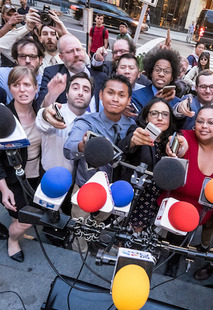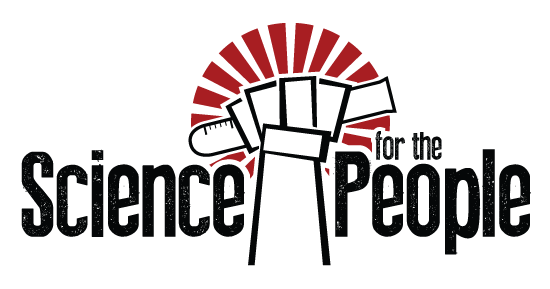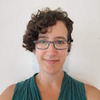Top Science Stories of 2018 #505
December 21, 2018

We're looking back over 2018 and calling out our favourite science news stories from this past year: the ones we think you should remember -- or hear about for the first time if maybe you've been taking a break from the internet -- and we've brought in a team of reports from Science News to do it. Buckle up for a whistle stop tour of this year's most fascinating science news.
Related links:
- Top 10 stories of 2018 on Science News
- News of the first gene-edited babies ignited a firestorm by Tina Hesman Saey
- Chinese scientists raise ethical questions with first gene-edited babies by Tina Hesman Saey
- The researcher who created CRISPR twins defends his work but fails to quell controversy by Tina Hesman Saey
- A buried lake on Mars excited and baffled scientists by Lisa Grossman
- Mars (probably) has a lake of liquid water by Lisa Grossman
- What does Mars’ lake mean for the search for life on the Red Planet? by Lisa Grossman
- An orbiter glitch may mean some signs of liquid water on Mars aren’t real by Lisa Grossman
- It’s official: We’re redefining the kilogram by Emily Conover
- Half a degree stole the climate spotlight in 2018 by Carolyn Gramling
- Limiting global warming to 1.5 degrees versus 2 has big benefits, the IPCC says by Carolyn Gramling
- Here’s how much climate change could cost the US by Carolyn Gramling
- Global carbon dioxide emissions will hit a record high in 2018 by Laurel Hamers
- Greenland crater renewed the debate over an ancient climate mystery by Carolyn Gramling
- A massive crater hides beneath Greenland’s ice by Carolyn Gramling
- Study casts doubt on whether adult brain’s memory-forming region makes new cells by Laura Sanders
- The debate over how long our brains keep making new nerve cells heats up by Laura Sanders
- Human brains make new nerve cells — and lots of them — well into old age by Laurel Hamers
Guests:
- Tina Saey
- Lisa Grossman
- Emily Conover
- Carolyn Gramling
- Laura Sanders
Guest Bios
Tina Saey
Molecular biology writer Tina Hesman Saey is a geneticist-turned-science writer who covers all things microscopic and a few too big to be viewed under a microscope. She is an honors graduate of the University of Nebraska-Lincoln where she did research on tobacco plants and ethanol-producing bacteria. She spent a year as a Fulbright scholar at the Georg-August University in Göttingen, Germany, studying microbiology and traveling. Her work on how yeast turn on and off one gene earned her a Ph.D. in molecular genetics at Washington University in St. Louis. Tina then rounded out her degree collection with a master’s in science journalism from Boston University. She interned at the Dallas Morning News and Science News before returning to St. Louis to cover biotechnology, genetics and medical science for the St. Louis Post-Dispatch. After a seven year stint as a newspaper reporter, she returned to Science News. Her work has been honored by the Endocrine Society and the Genetics Society of America.
Lisa Grossman
Lisa Grossman is the astronomy writer for Science News. Previously she was a news editor at New Scientist, where she ran the physical sciences section of the magazine for three years. Before that, she spent three years at New Scientist as a reporter, covering space, physics and astronomy. She has a degree in astronomy from Cornell University and a graduate certificate in science writing from UC Santa Cruz. Lisa was a finalist for the AGU David Perlman Award for Excellence in Science Journalism and received the Institute of Physics/Science and Technology Facilities Council physics writing award. She interned at Science News in 2009-2010. She lives in Boston with her husband, her toddler and a dark matter cat.
Emily Conover
Physics writer Emily Conover joined Science News in 2016. She has a Ph.D. in physics from the University of Chicago, where she studied the weird ways of neutrinos, tiny elementary particles that can zip straight through the Earth. She got her first taste of science writing as a AAAS Mass Media Fellow for the Milwaukee Journal Sentinel. She has previously written for Science Magazine and the American Physical Society. She is a two-time winner of the D.C. Science Writers’ Association Newsbrief award.
Carolyn Gramling
Carolyn Gramling is the Earth & Climate writer at Science News. Previously she worked at Science magazine for six years, both as a reporter covering paleontology and polar science and as the editor of the news in brief section. Before that she was a reporter and editor at EARTH magazine. She has bachelor’s degrees in Geology and European History and a Ph.D. in marine geochemistry from MIT and the Woods Hole Oceanographic Institution.
Laura Sanders
Based in Corvallis, Oregon, contributing correspondent Laura Sanders reports on neuroscience and writes Growth Curve, a blog about the science of raising kids, for Science News. She earned her PhD in molecular biology from the University of Southern California in Los Angeles, where she studied the nerve cells that compel a fruit fly to perform a dazzling mating dance. Convinced that she was missing some exciting science somewhere, Laura turned her eye toward writing about brains in all shapes and forms. She holds undergraduate degrees in creative writing and biology from Vanderbilt University in Nashville, where she was a National Merit Scholar. Growth Curve, her 2012 series on consciousness and her 2013 article on the dearth of psychiatric drugs have received awards recognizing editorial excellence.























